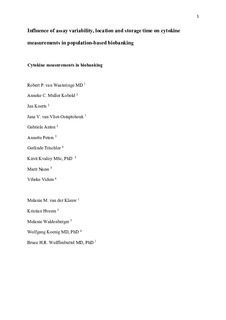| dc.contributor.author | van Waateringe, RP | |
| dc.contributor.author | Muller Kobold, AC | |
| dc.contributor.author | Van Vliet-Ostaptchouk, JV | |
| dc.contributor.author | Van der Klauw, MM | |
| dc.contributor.author | Koerts, J | |
| dc.contributor.author | Anton, Gabriele | |
| dc.contributor.author | Peters, Annette | |
| dc.contributor.author | Trischler, G | |
| dc.contributor.author | Kvaløy, Kirsti | |
| dc.contributor.author | Næss, Marit | |
| dc.contributor.author | Videm, Vibeke | |
| dc.contributor.author | Hveem, Kristian | |
| dc.contributor.author | Walderberger, M | |
| dc.contributor.author | Koenig, W | |
| dc.contributor.author | Wolffenbuttel, BHR | |
| dc.date.accessioned | 2018-06-01T06:22:24Z | |
| dc.date.available | 2018-06-01T06:22:24Z | |
| dc.date.created | 2017-12-19T08:46:08Z | |
| dc.date.issued | 2017 | |
| dc.identifier.citation | Biopreservation and Biobanking. 2017, 15 (6), 512-518. | nb_NO |
| dc.identifier.issn | 1947-5535 | |
| dc.identifier.uri | http://hdl.handle.net/11250/2499979 | |
| dc.description.abstract | Background: In the present study, we examined the effect of sample storage on the reproducibility of several inflammatory biomarkers, including high-sensitivity C-reactive protein (hsCRP), high-sensitivity interleukin-6 (hsIL6), and high-sensitivity tumor necrosis factor alpha (hsTNFα). In addition, we assessed inter- and intra-assay variability between collaborating biobanks.Methods: In total, 240 fasting plasma samples were obtained from the LifeLines biobank. Samples had been stored for less than 2 or more than 4 years at −80°C. Measurements were performed at three different laboratories. hsCRP was measured by immunonephelometry and ELISA, hsIL6, and hsTNFα samples were measured with ELISAs from two different manufacturers. For confirmation, similar analyses were performed on samples obtained from a subpopulation of 80 obese individuals. Passing–Bablok regression analysis and Bland–Altman plots were used to compare the results.Results: We observed good stability of samples stored at −80°C. hsCRP measured on the day of blood draw was similar to levels measured after more than 4 years of storage. There were small interlaboratory differences with the R&D ELISAs for hsIL6 and hsTNFα. We found a linear correlation between the Bender Medsystems ELISA and the R&D ELISA for hsIL6, with significantly higher levels measured with the R&D ELISA. Over 90% of hsTNFα samples measured with the IBL ELISA were below the detection limit of 0.13 ng/L, rendering this assay unsuitable for large-scale analysis. Similar results were found in the confirmation study.Conclusion: In summary, plasma hsCRP showed good stability in samples stored for either less than 2 years or more than 4 years at −80°C. Both the R&D and Bender Medsystems for hsIL6 measurement yielded similar results. The IBL hsTNFα assay is not suited for use in biobanking samples. Assays for the measurement of inflammatory biomarker assays should be rigorously tested before large sample sets are measured. | nb_NO |
| dc.language.iso | eng | nb_NO |
| dc.publisher | Mary Ann Liebert | nb_NO |
| dc.title | Influence of Storage and inter- and intra-Assay Variability on the Measurement of Inflammatory Biomarkers in Population-Based Biobanking | nb_NO |
| dc.type | Journal article | nb_NO |
| dc.description.version | submittedVersion | nb_NO |
| dc.source.pagenumber | 512-518 | nb_NO |
| dc.source.volume | 15 | nb_NO |
| dc.source.journal | Biopreservation and Biobanking | nb_NO |
| dc.source.issue | 6 | nb_NO |
| dc.identifier.doi | 10.1089/bio.2017.0001 | |
| dc.identifier.cristin | 1529352 | |
| dc.description.localcode | This is a submitted manuscript of an article published by Mary Ann Liebert in Biopreservation and Biobanking, 1 Dec 2017. Locked until 1.12.2018 due to copyright restrictions. | nb_NO |
| cristin.unitcode | 194,65,20,15 | |
| cristin.unitcode | 194,65,20,0 | |
| cristin.unitcode | 194,65,15,0 | |
| cristin.unitname | Helseundersøkelsen i Nord-Trøndelag | |
| cristin.unitname | Institutt for samfunnsmedisin og sykepleie | |
| cristin.unitname | Institutt for klinisk og molekylær medisin | |
| cristin.ispublished | true | |
| cristin.fulltext | preprint | |
| cristin.qualitycode | 1 | |
